Cold Hardy Palms
Check out Our Favorite Palm Tree Seeds for more palm tree seeds
Check out Our Favorite Bananas for more banana seeds
Find your zone using your zipcode at Garden Web's Zone Finder.
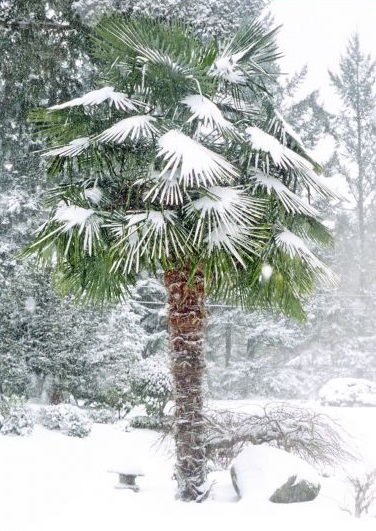
Trunks are usually covered with a loose mat of coarse gray or brown fiber. In older individuals the fiber sloughs away to reveal a smooth ringed surface.
Has light to dark green palmate leaves that are lighter, almost silvery (glaucous), on the underside.
It is commonly grown as a landscape specimen in central and northern Florida, the southeastern U.S. Atlantic and Gulf Coasts, and in mild areas along the west coast. It has been sighted in northerly latitudes from Charlotte, North Carolina to Atlanta, Georgia to Vancouver, British Columbia.
This palm makes a great accent which fits well into small areas like courtyards and entries. It is a tough plant and survives in hot urban landscapes and even thrives there if watered and fed. This palm is perfect for containers if care is taken that they are well drained.
Hardy to zone 7b.
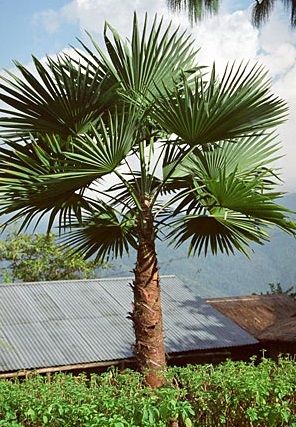
It is commonly known as Windamere palm, for the locality where its first botanical description was made, the garden of the famous Windamere Hotel in Darjeeling, India. It was formally photographed and collected for the first time only in 1992 during the Royal Botanic Garden Edinburgh Sikkim Expedition. It is considered a temperate palm, and has been reported to withstand a wide range of climates, from tropical, subtropical to cold and wet conditions. It is native to Sikkim in the Himalayas, where it has been reported from a range of elevation between 3500 to 7000 feet. It remains in the wild in just one tiny, heavily altered location which is immediately threatened by deforestation. Cold hardy to about 28 degrees.
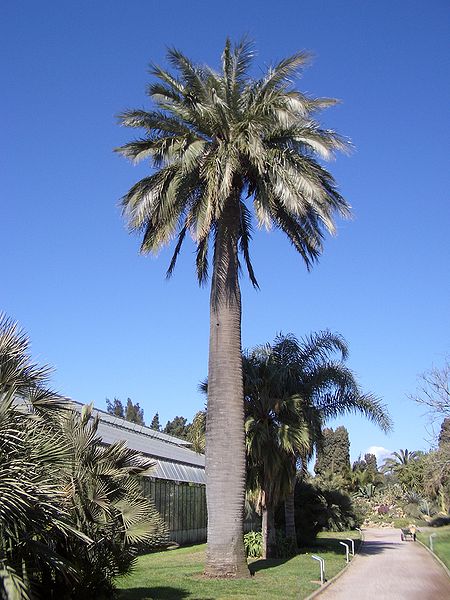
It is highly drought tolerant but will also do well in cold and humid conditions. It does not need hot summers to grow well and in winter it can take severe frost down to -16°C (3°F) unharmed. For many temperate climates it is the only large pinnate palm which is cold-tolerant enough to be successful long-term. Many fine, centennial examples can be admired for instance in California, Australia and along the Mediterranean, in southern Switzerland, along the windy Atlantic coast of France and even in Britain. And there are many other areas where it would do well but has not been tried much.
Germination and establishment are slow but easily accomplished and young plants are sought after and of high value as they are rarely found in the nursery trade.

One of the slowest growing palms in the palmae family. Very similar to its brother the Windmill Palm (Trachycarpus fortunei), the Miniature Chusan Palm has distinctive characteristics that differentiates it from the Windmill Palm. The Windmill Palm (Trachycarpus fortunei) has and overall appearance of being more dainty and leggie.
The Miniature Chusan Palm (Trachycarpus wagnerianus) has and overall appearance of being more compact. It has smaller leaves that are much more stiff and deeply-cut. The leaves are green to dark green in color and are rounded in outline and held on shorter stems. Therefore having shorter stems they are more resilient and will not bend under the weight of snow or ice. The Waggie Palm is very cold hardy withstanding temperatures down to 0 degrees and below with little to no damage. It has shown no leaf damage in Zone 6 and will make it through anything this climate can throw at it.
The Miniature Chusan Palm is also disease free and worry free. This palm enjoys full sun to partial shade and will do best with well drained soils. It is adaptable for both containers or gardens, making it the ideal choice for the tropical look with no worries of freezing cold temperatures.
This palm tree will make a great addition to any home office or landscape. It will give a sense of the tropics with little cost.

Grown regularly in zone 8, this palm has been proven to survive 0° F. when heavily mulched and protected. Generally considered safe to grow in zone 7 if heavily protected, it is suspected it could survive zone 6 under certain conditions.
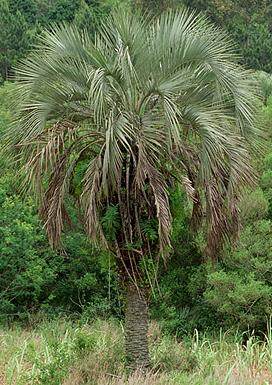
It produces bright orange fruit, called pindo dates in the US, and as Jelly is made from these it accounts for the common European name,'Jelly Palm'. Although the fruit is supposed to be delicious, there seems little evidence of it being grown commercially as a fruiting palm. The flowers are numerous, very small, creamy yellow and are borne on 3-4 feet long inflorescences bearing separate male and female flowers. Pollination is by wind and insects.
The 1" yellow to orange fruits are round or oval shaped, and hang in large bunches. Each fruit contains a single large seed which looks like a tiny Coconut, with the characteristic 3 pores at one end. The sweet, but tart, flavour is a mixture of apricot, pineapple and banana. Fruits are harvested as they ripen, or if the whole bunch is harvested they tend to ripen all at once. They can be eaten fresh or puree'd, and make excellent jelly as well as wine. They can be stored for about a week refrigerated.
Cold hardy to about 10 degrees for short periods of time.
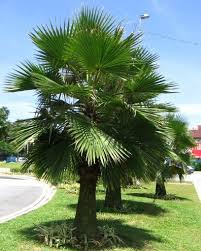
Small black colored fruit with a taste resembling a date in clusters.
Endangered in its own habitat on the Guadalupe Islands, this palm is becoming popular in other parts of the world. The sweet pulp from the fruit adds to its attraction, along with its bluish-green fan leaves. It grows to 30 feet tall and drops its dead leaves forming scars on the trunk where the leaves once were. It takes full sun with occasional summer water and does well along the coast.
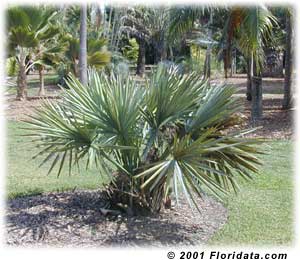
This species is best suited for subtropical and warm temperate climates, but it has been successfully cultivated in areas such as central Tennessee and the greater Washington, DC Metropolitan area. Sabal minor is a recommended horticultural plant and is a popular choice for coastal resort areas from Virginia Beach to southern Texas. Get your Sabal minor Dwarf Palmetto today and bring a unique touch of nature to your landscape.

The large leaves have a dull finish and are a medium green, sometimes yellow-green, in color depending on the individual and situation. Each leaf is up to 12 feet long overall including the spineless petioles (leaf stems) which measure about 5-6 feet in length. They are up to 6 feet in width with drooping leaf segments about 3 ft (0.9 m) long and 2-3 in (5.1-7.6 cm) wide. These segments are split to about half the width of the leaf and typically slough off tan fibers at the edges. Cabbage palm leaves are said to be costapalmate meaning that the leaflets are arranged on the stem in a pattern that is midway between palmate (leaflets arranged like the fingers on the palm of your hand) and pinnate (feather shaped).
Unlike the royal palm, the cabbage palm has no crownshaft. Leaves emerge directly from the trunk which is often covered with old leaf stem bases that are arranged in an interesting criss-cross pattern. Depending on the individual these may persist to the ground even in very old palms. Other trees in the same vicinity may shed their leaf attachments or "boots" as they are sometimes called very early in life revealing a rough fibrous brown trunk. Eventually the trunk will age to gray and the surface will become smooth.
The cabbage palm's creamy white flowers are arranged on a long branched inflorescence that appears in summer. In mid-summer the cabbage palm bears creamy white flowers on a long branched inflorescence that is held completely within the crown. Flowers are followed in late fall or early winter by black spherical fruit that is about one third of an inch in diameter. Inside is a shiney brown seed that is about one quarter of an inch in diameter. Squirrels, raccoon and many other species of mammal and bird enjoy visiting the cabbage palm for dinner feasts of fruit and seed.
This southeastern U.S. native palm occurs near the coast, from the North Carolina barrier islands to South Carolina, to Georgia, down to the Florida Keys and then up the Gulf Coast to the northwestern Florida panhandle. Sabal palmetto is also native to Cuba and the Bahamas. It is often planted all along the Gulf Coast. Cabbage palm occurs along beaches, sandy bay and estuary shores. It inhabits the margins of tidal flats and marshlands where it often crowds into extensive groves. It's also encountered inland in hardwood hammocks and pine flatwoods.
Sabal palmetto is very salt and drought tolerant and can be used in beachside plantings. It is able to adapt to most types of soil. Cabbage palms are easy to transplant if they have at least six feet of trunk.
Requires Full sunlight to some shade. Trunk development is suppressed in heavily shaded specimens. Average moisture will do. Tolerates drought, standing water and brackish water. Hardy to USDA Zones 8-10. This is a hardy frost tolerant palm that can survive many degrees below freezing.
Two cabbage palmettos shade a bayside picnic area while framing Tampa Bay's Sunshine Skyway Bridge. The cabbage palm is used as an ornamental and street tree, well adapted for group, specimen or avenue plantings. This palm is very salt tolerant and can be grown on the beach or directly at the water's edge of bays and inlets. The state of Florida has been planting cabbage palmettos by the hundreds along the state's freeways. The palm groves refresh the eye and absorb the road noise providing a calming influence for both motorists and the environment. Cabbage palm is very low maintenance and drought resistant making if a perfect choice for urban plantings.
Young potted cabbage palms will take up to ten years before they begin to form a trunk. They grow slowly these first years as root system and the crown forms. Once the trunk does begin to develop the growth rate increases somewhat. The growth rate of cabbage palm can be significantly increased with regular watering and feeding.
Cabbage palm is the state tree of Florida and is displayed on the state flag of South Carolina whose nickname is the "Palmetto State". The durable trunks are sometimes used for wharf pilings, docks and poles. Brushes and brooms can be made from young leaves, and the large fan shaped leaves have been used by the Seminole Indians in Florida as thatch for traditional pavilions, called chickees.
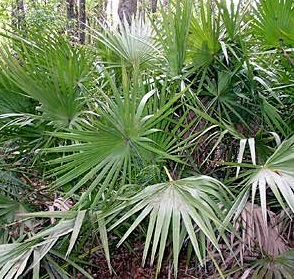
Saw palmetto occurs naturally on the coastal plain from
South Carolina to southeastern Louisiana. It grows in a wide
range of habitats from seaside sand dunes and dry scrub to
moist forests, pine flatwoods and even wetlands. Saw palmetto
can be the dominant ground cover in certain southeastern pine
forests, sometimes covering hundreds of acres. Culture: Once
established, saw palmetto is virtually maintenance-free.
Light: Prefers full sun, but can tolerate partial sun.
Moisture: Tolerates drought but can also tolerate moderately
moist soils.
Hardiness: Fully hardy to zone 7, this palm has been seen
growing in zone 6, but does suffer foliage damage at 10 degrees
F. and complete foliage loss at 3-5 degrees F.
Saw palmetto is a beautiful little palm and richly deserves a place in the ornamental landscape. Plant saw palmettos in front of clumps of larger palms, or even underneath large palms. They look good massed in clumps in mixed borders, or as framing hedges. Use as accents to trees or in foundation plantings.
Features: The berries of saw palmetto are used as a treatment for Benign Prostatic Hyperplasia or enlarged prostate gland. They are also used as a diuretic to tone the bladder, improve urinary flow, and decrease urinary frequency. They may help prevent prostate cancer.

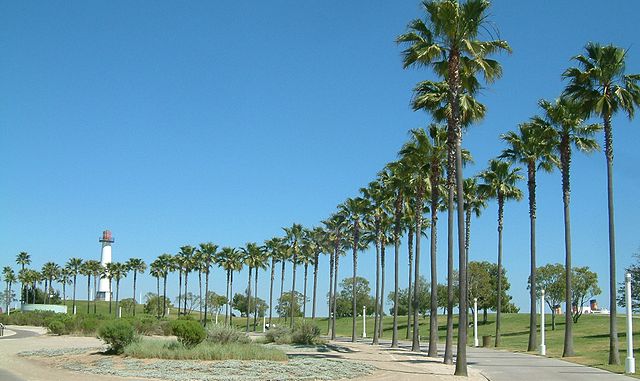
Prefers full sun and tolerates 18 to 20 degrees F. Fairly fast growing and commonly available. 12 to 15 degrees will defoliate this species.

The Queen palm can tolerate to about 20 degrees, 17 degrees or colder will kill this species. It demands full sun.
Cold Hardy Bananas
Note: All banana leaves, even of the most cold hardy species, will be damaged by frost and killed outright by a hard freeze. But many underground rhizomes are much cold hardier than people realize. This means that that the underground root will sprout new growth in the Spring.

A beautiful, high altitude banana from China's Yunnan Province and Arunachal Pradesh in India that has proven to be a very interesting cold tolerant species that will thrive under similar conditions as the legendary Musa basjoo and M. sikkimensis, even though not quite as hardy. It is a slender stemmed, extremely fast growing plant with large leaves supported by waxy white leaf stalks. Some confusion surrounds the introduction of this banana into cultivation: and it now turns out to be a new species, described in 2007 by Markku Hakkinen as Musa yunnanensis.
Considered hardy to zone 5. Exact hardiness is unknown. It may be close to as hardy as Musa basjoo, and has reportedly tolerated temperatures down to 10F. Upon freezing weather the plant will die back to its base, but quickly grows back once weather warms up.
Cold Hardy Yuccas
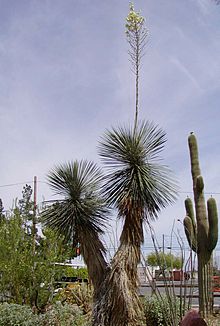
Cattle relish the young flower stalks, and chopped trunks and leaves serve as emergency food during droughts. Indians ate the flower buds, flowers, and young flower stalks of this and other yuccas, either raw or boiled.
Yucca elata is a common, widespread and quite distinctive species, growing tall and eventually branching, forming tree-like plants up to 15 feet high, resembling the Joshua tree through generally smaller, with longer leaves and fewer branches. Ranges of the two overlap in southwest Utah and northwest Arizona, but the soaptree yucca is more common further east, in the grasslands and foothills of central and southeast Arizona, and the flat plains of New Mexico.
Leaves are pale or bright green in color, thin and flexible, up to half an inch across (slightly wider in the middle) and between 10 and 35 inches long. The edges are white, as are the short terminal spines and the long, curly filaments that grow most densely towards the center. Plants are old before they branch, hence most specimens have only one stem; the (usual) maximum number observed is seven. Dead leaves hang back against the stem and remain there for many years. Flower clusters are borne on stems rising 2 or 3 feet above the leaves. Flowers are pendant, globular or bell-shaped.
Hardy to zero degrees, also makes a great container plant when young.
Zones 6-10.
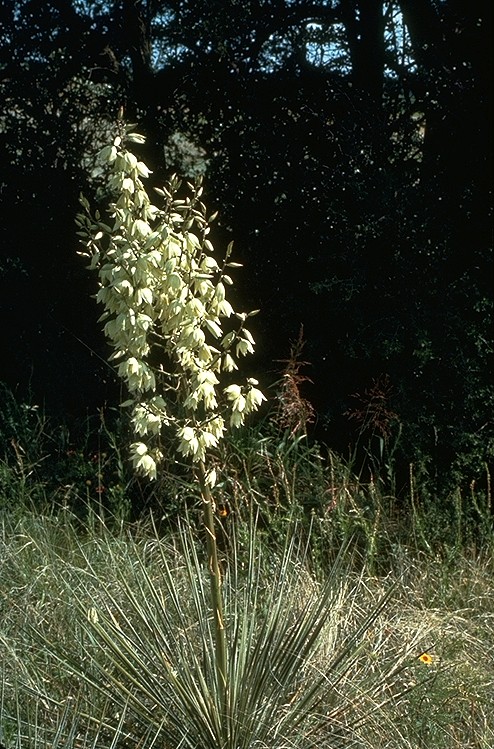
It is deer resistant, drought tolerant and makes a good bedding plant for rock gardens or xeriscapes. Best suited for zones 4-8.

Light: prefers full sun, but will tolerate some light shade.
Moisture: average to dry soild - drought tolerant.
Hardiness: USDA Zones 6-10.
Use in mixed borders and natural areas. Excellent in rock gardens and as an accent among other perennials. Can be grown in outdoor container.
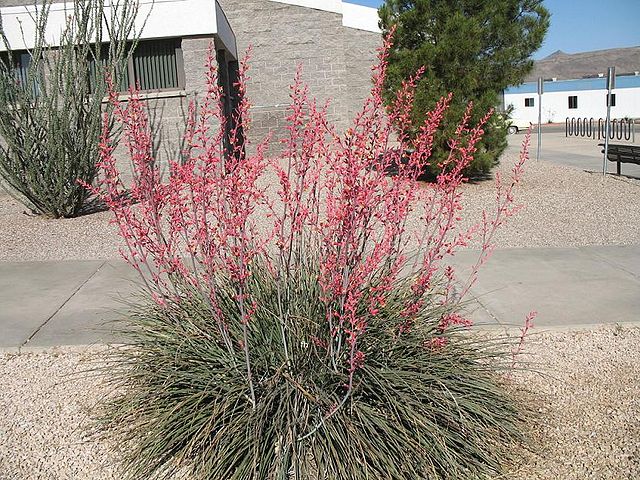
Hesperaloe parviflora has narrow evergreen leaves with a fringe of white threadlike hairs along their edges and grows in clumps 3–6 feet high and wide. Red or yellow tubular flowers are borne on branching flower stalks (inflorescences) up to 5 feet tall from late spring to mid-summer.
This species has become popular in xeriscape landscape design for public and private gardens in California and the Southwestern United States. The plant's qualities include drought tolerance, heat resistance, low maintenance needs, hummingbird attracting flowers, and an architectural form. It also is a spineless alternative to Agave and Yucca horticultural species.
Hardy to well below 0°F some say as low as -20°F (USDA zone 5). It is a good clean plant for desert and succulent gardens, planted in masses or used in pots.

